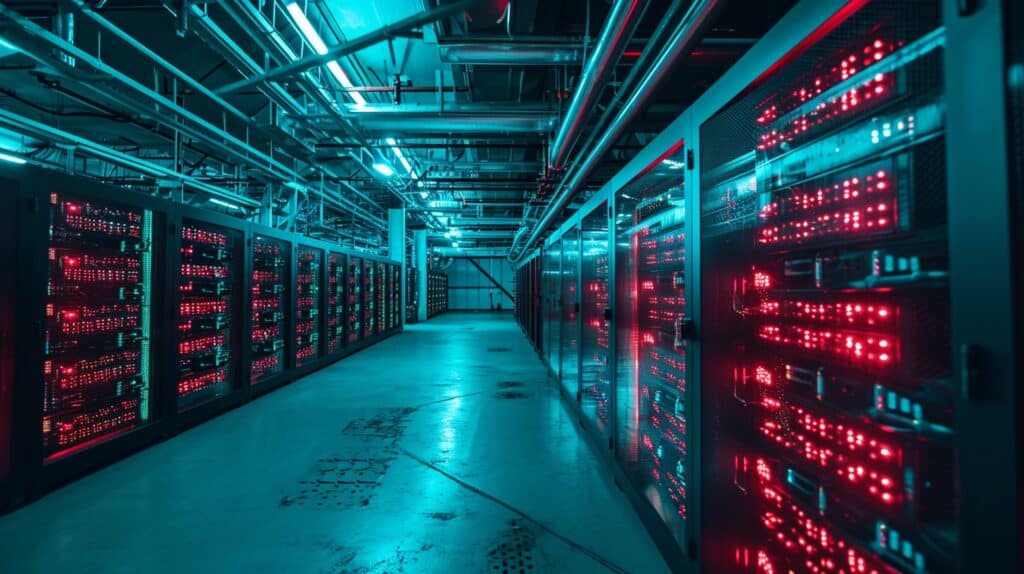Ever felt like you’re wandering into the crypto bash just a tad late, surrounded by folks chattering in what might as well be an alien tongue? Trust me, I know that furrowed-brow feeling all too well.
When I first locked eyes with Bitcoin, it was like trying to read a map with no legend. Yet, after diving headfirst into the vast ocean of digital currencies—yep, there’s a dizzying 8,800 and counting—I managed to resurface clutching some shiny insights that’ll turn those cryptic codes into plain sailing for you.
Consider this guide your trusty crypto compass; it’s here to steer you clear from the jittery shores of investment anxiety and set your course towards confident digital asset mastery.
So, are you ready to unwrap the enigma wrapped in this digital riddle? Let’s embark on our quest through the cryptocurrency labyrinth—together!
Key Takeaways
Cryptocurrency is like online money that uses special tech to keep your coins safe. There are over 8,800 different kinds, and they’re worth a lot when added up.
Crypto mining is how new coins are made. It’s also how all the transactions get checked and kept secure. But it uses lots of electricity.
Exchanges are places where you can buy, sell, or trade cryptocurrencies. When choosing one, look at fees, safety, what coins they have, and customer support.
Bitcoin started the whole crypto thing in 2009. There will only ever be 21 million Bitcoins. Altcoins are other cryptos that came after Bitcoin and offer different features.
Investing in crypto can mean trading coins or owning part of businesses related to crypto. Always remember, investing comes with risks—so do your homework before spending money!
Table of Contents
Understanding Cryptocurrency Basics

Let’s dive right in and crack the code on cryptos, shall we? Think of it as deciphering a secret language where “blockchain” is king and “Bitcoin” is its firstborn.
What is Cryptocurrency?
So, cryptocurrency is basically digital money. It’s like the dollars and coins in your wallet, but you can’t touch it because it’s all online. Their special trick is cryptography, which keeps everything safe and sound so no one can cheat the system.
Think of it like a game with super-secure rules that everyone on the internet agrees to play by. Here’s a cool fact: there are over 8,800 different cryptocurrencies out there! And their total value? A whopping $1.32 trillion! Big numbers, right? They don’t have any one boss controlling them either — they’re decentralized, meaning lots of computers across the globe work together to keep track of all transactions.
Pretty smart way to do things if you ask me!
How Does Cryptocurrency Work?
Cryptocurrency is like digital money that lives on the internet. It uses special tech called blockchain to keep everything safe and sound. Imagine a huge book where all the coin moves are written down; that’s what blockchain does, making sure no one can cheat or make copies of their coins.
How to get started with cryptocurrencies
How Does Cryptocurrency Work? A Beginner’s Guide – Coursera
- Create and fund your account. When you’ve selected a broker or exchange, the next step is to open an account. …
- Buy crypto. You can make your first cryptocurrency purchase when your account is set up and verified. …
- Select a storage method.
You’ve got these things called wallets, but not like the one in your pocket. These digital wallets hold your crypto coins. When you want to send some coin to a friend, it’s pretty much like sending an email – super easy but secure because of all that blockchain magic happening behind the scenes! They’re kept locked tight with unique keys so only you can access them—think of it as having a secret code for an uncrackable safe.
What Is Blockchain Technology?
Blockchain technology is like a digital ledger that keeps track of crypto money. Imagine it as a chain where each link holds information about transactions. Every time someone makes a deal, the details get added to a new block in the chain.
This setup is super tough to mess with because once something goes in, changing it would mean messing up all the blocks that come after – and that’s just not worth anyone’s time or effort.
Now, I’ve got to tell you, this blockchain thing doesn’t rely on just one computer or person; it spreads out across tons of them all over the place. So if one goes kaput, no sweat—the rest keep everything running smoothly.
Because everybody has to agree before any changes are made (that’s the consensus rule), tricking the system is pretty much impossible. You can trust that your crypto cash stays safe and sound on blockchain’s watch.
The Role of Crypto Mining

Alright, let’s dive into the virtual gold rush of our times—crypto mining! Imagine a world where your computer hustles to solve complex puzzles and, in return, you could potentially pocket some digital coins; that’s crypto mining for ya.
It’s not just about minting new coins, either; it’s the heartthrob of the blockchain, making sure every transaction is legit and secure—it’s kind of like keeping score in an endlessly ongoing game of cyber Sudoku… but with actual money on the line.
How Does Crypto Mining Work?
So, you’ve heard about crypto mining and wonder how it works? It’s like a digital gold rush, where miners use computers to dig up coins. Here’s the scoop:
- First off, crypto mining needs a lot of computer power. Miners use their rigs to solve tricky math problems.
- These math challenges are there to check transactions. They keep everything honest and secure on the blockchain.
- Solving these puzzles is called “proof of work.” It’s a way to make sure new transactions are legit before adding them to the blockchain.
- Now, imagine a bunch of transactions lined up. Miners take these and put them into what we call a block.
- To add this block to the chain, miners compete to solve a complex puzzle first. It’s like winning a race.
- The winner gets to add their block of transactions to the blockchain. This process stops someone from spending their coins twice.
- After solving the puzzle, they shout out “Bingo!” Just kidding—they actually broadcast their solution to other miners for verification.
- If everyone agrees the miner’s answer is correct, that new block is added officially. The miner gets some freshly minted bitcoins as a reward.
- But here’s a kicker: this whole mining thing eats up more electricity than some countries! Yeah, it can be heavy on power use.
The Impact of Crypto Mining on Cryptocurrency Value
Alright, let’s dive right from how mining works to its effect on a coin’s worth. Crypto mining is like a double-edged sword when it comes to the value of cryptocurrencies. On one side, it helps keep the network secure and processes transactions.
Without miners doing their tough work, cryptos wouldn’t really have any value because there’d be no way to make sure everything’s running smoothly and safely.
But here’s the catch – all that mining needs tons of power. We’re talking as much electricity as what some entire countries use! Because of this, people are starting to look at other ways that don’t need so much energy.
Alternatives like proof of stake are gaining fans because they don’t gobble up as much juice but still keep things ticking over nicely.
Mining also controls how many new coins pop up on the market. If too many coins get mined too quick, their value could take a hit because there’s just too many out there – you know, supply and demand stuff.
But if miners slow down or stop (maybe because it costs them more in electricity than they’d earn back), that can push prices up, since new coins aren’t hitting wallets fast enough.
So you see, mining doesn’t just print out new crypto coins – it has a real pull on their price tags too!
Introduction to Crypto Exchanges

Now, let’s dive into the bustling world of crypto exchanges, shall we? Think of these as the stock markets for cryptocurrencies—places where your digital dollars turn into Bitcoin, Ethereum, or maybe some Dogecoin to show off in the group chat.
What are Crypto Exchanges?
Crypto exchanges are like online markets where you can buy and sell digital money. Think of them as the high-tech version of stock trading platforms but for cryptocurrencies such as Bitcoin, Ethereum, and thousands of others.
You’ve got different kinds out there – centralized ones that feel a bit more traditional because they let you use actual dollars to trade, and decentralized ones where it’s all about swapping crypto with other people directly without any middleman.
Bigger players might look for an institutional crypto exchange that offers extra services tailored for businesses or serious investors. No matter which kind you choose, make sure it’s easy to use and keeps your coins safe – kinda like how you pick a bank to trust with your cash.
Choosing the right exchange is key; it’s all about finding that sweet spot of good security, solid features, and not too many fees that eat into your potential profits.
How to Choose a Crypto Exchange
Alright, I’ve been down this road. Picking a crypto exchange is like finding the right pair of shoes—you need a good fit. Here’s what to look out for:
Check the fees! Nobody likes surprises, especially when it comes to money.
- Look at trading fees, withdrawal fees, and any other charges that might pop up.
- Some exchanges charge more for certain services, so know what you’ll be paying.
Safety first, my friend.
- Read reviews and research how the exchange keeps your coins safe.
- See if they’ve got insurance against theft or hacks.
Make sure they’ve got what you want.
- If you’re into altcoins or looking for that new token listing on the exchange, see if they offer a wide variety.
- You wouldn’t shop at a store that doesn’t carry your favorite brands, right?
User experience can make or break it.
- A good interface helps you trade without pulling your hair out.
- Try the mobile app too; trading on the go should be smooth.
Sometimes you just need a bit of help—check their customer support.
- Quick response times and helpful service go a long way.
Liquidity matters—you want to move your money without an issue.
- High liquidity means easier buy and sell orders without affecting prices much.
Research is key (I can’t stress this enough).
- All investors have got to do their homework before making decisions—it’s about your money, after all.
Think about where you live.
- Make sure the exchange works well in your country and accepts your currency.
Look at deposit and withdrawal options.
- Easy access to deposit funds and cash out is crucial; check if they take credit cards or PayPal.
Read the fine print about limits.
- Some places restrict how much you can deposit or withdraw each day; make sure it fits your needs.
The Evolution of Cryptocurrency

Alright, let’s dive into the time machine and explore how cryptocurrency has evolved from an obscure digital anomaly to a financial behemoth that’s got everyone from my barista to Wall Street brokers buzzing.
It’s a ride—from Bitcoin’s first ‘cha-ching’ moment to today’s sprawling crypto ecosystem that just refuses to sit still. Buckle up, folks—it’s quite the story!
Why Has Crypto Become so Popular?
Crypto is taking the world by storm, and I’ve seen why. People love it because it’s kind of like being a pioneer in the wild west of finance. It shakes things up, making room for everyone to get a slice of the pie.
With Bitcoin leading the way, reaching over $65,000 each, folks are paying attention.
Now we have more than 8,800 digital currencies with a massive value when you add them all up—over $1.32 trillion! So what’s pulling everyone in? Well, crypto assets aren’t just about spending money; they’re about changing how we deal with money altogether.
You can buy stuff without using banks or even borrow cash through this cool thing called decentralized finance.
So yeah—crypto has grown big time and keeps finding new ways to be useful day by day. Looking at all these changes makes me think that pretty soon we’ll talk about Altcoins next; those are other cryptocurrencies not named Bitcoin.
Bitcoin: The Pioneer of Cryptocurrency
Bitcoin really kicked off the whole crypto craze. It’s like the first kid on the block, showing everyone else how it’s done. Imagine a kind of money that you can’t hold in your hand because it lives on the internet—that’s Bitcoin for you, and folks everywhere are using it to buy stuff or as a way to grow their cash.
So Satoshi Nakamoto is this mystery person (or maybe even a group of people), who started Bitcoin in 2009. They set up this smart system where all Bitcoin dealings are written down for everyone to see—this is what people call blockchain technology.
It makes sure no one tries anything sneaky with their Bitcoins because there’s always a record of every move they make. And guess what? There will only ever be 21 million Bitcoins out there.
Right now, we’ve got over 18 million already playing the game—pretty wild, huh?
Altcoins: The Alternatives to Bitcoin
So, Bitcoin really kicked things off, but let’s dive into altcoins. They’re like the other fish in the big crypto sea. We’ve got a whole bunch of them—Ethereum, Litecoin, Polkadot—you name it.
These guys are giving investors more choices than just Bitcoin.
Each altcoin has its own cool stuff going on. Take Ethereum, for example; it’s huge with smart contracts that can power all sorts of apps and business deals without needing a middleman.
Then there’s Litecoin zipping transactions faster than you can say “crypto.” And don’t even get me started on Polkadot and its decentralized finance wizardry! What’s great is they each have their own chance to shine and grow.
But hey, investing in altcoins isn’t just a walk in the park. You’ve gotta do your homework because these coins can jump around in value all by themselves—not always following Bitcoin’s lead—which means you could mix up your investments a bit more.
Just remember to research before you throw down any cash; these opportunities come with their risks too!
Exploring Non-Fungible Tokens (NFTs)

Non-fungible Tokens (NFTs) are like collectible digital treasures. Each one is special and can’t be swapped for something else, kind of like how a signed baseball card isn’t the same as just any old card.
Picture this – I’ve got an NFT that’s a piece of art only I own, even if someone else has a copy, they don’t have my unique version.
Here’s the cool part – creators make money from their work in new ways with NFTs. Artists, musicians, and all kinds of talented folks put their stuff online as NFTs. When people buy them, it’s like saying, “I believe in your work!” And when these get sold again? The original creator still gets a cut! It’s not just about owning digital things; it’s also helping the people who create them keep doing what they love.
While non-fungible tokens offer a unique form of value and ownership, different from traditional cryptocurrencies, they create a fascinating dynamic when we consider the fluctuating SOLUSDT price.
Investing in Cryptocurrency

Hey, guys! So you’ve got a bit of dough you’re looking to grow, and you’re thinking, “Cryptocurrency might just be the golden ticket,” right? Well, strap in because we’re about to deep-dive into the wild world of crypto investing—where the stakes are high but so could be your next beach house (or ramen budget—crypto can be a rollercoaster, my friend).
Let’s navigate this digital gold rush together and see if we can’t come out on top.
Understanding Crypto Trading
I get it, the world of crypto trading can seem like a wild ride. Imagine stepping into a digital marketplace where you buy and sell things that aren’t even physical—yep, that’s cryptocurrency for ya! So here’s the scoop: you pick an exchange (think Binance or Coinbase) as your playground to trade these virtual currencies.
Now, think about playing a video game, but instead of points, we’re dealing with real money. You’ve got to stay sharp because prices move up and down superfast—hello volatility! And just like in any good game, there are strategies.
Some folks day-trade; they buy low in the morning and hope to sell high by nightfall. Others sit tight on their stash of coins, hoping they’ll be worth more later on—kinda like collecting rare baseball cards.
Look at Bitcoin—it was the first one out there, and now tons of people want it. Just be ready; this is not your grandpa’s stock market… It’s faster-paced and right at your fingertips 24/7.
Feeling adventurous? Then crypto trading might just be your next big thing.
The Concept of Crypto Mining as an Investment
So, we’ve talked about trading, but there’s this whole other side to making money with crypto—mining. Think of crypto mining like digging for gold, only you do it on your computer.
You solve tricky math problems and in return, you can get some cryptocurrency without having to buy it. It’s a bit like getting paid for doing homework that helps keep the digital money world running smoothly.
Now, mining isn’t just about earning coins; it’s also an investment move. When you set up your gear and start mining using proof-of-work or proof-of-stake systems, you’re betting that the time and money you put into it will pay off because the coins you mine today could be worth more tomorrow.
Just remember—this kind of investing takes a lot of power and some smart tech skills to make sure everything runs right and makes sense money-wise!
The Fundamentals of Crypto Staking
Mining might not be everyone’s cup of tea, but there’s another way to get involved and possibly earn from your crypto stash—it’s called staking. Think of it like earning interest in a savings account but for digital currency.
You lock up some coins and help keep the network safe and running smoothly. In return, you earn rewards—more coins!
Staking is all about participating in the process that decides which new transactions are added to the blockchain. And it doesn’t require fancy equipment or huge amounts of electricity like mining does.
If a coin uses proof-of-stake (PoS), you can just hold on to a set amount of that coin and start staking right away. It’s a great way to potentially build up more crypto without buying more, plus you’re supporting the system while doing it!
Bitcoin ETFs
So, let’s chat about Bitcoin ETFs. Think of them like a bridge. They link the traditional stock market world with the sizzlin’ hot realm of cryptocurrency. You don’t buy Bitcoin directly; instead, you nab some shares that follow Bitcoin’s price moves.
It’s all done through your regular investment account—simple as grabbing a soda from the fridge.
Now, if diving into actual Bitcoin feels like jumping off the high dive, then Bitcoin ETFs could be more like wading in from the steps. They offer a taste of crypto without needing to learn all that wallet and key stuff—perfect if you’re just getting your feet wet! Plus, they come with some new ways to put money into this digital gold rush.
Just always keep an eye out for how it fits with your whole money plan, alright?
Investing in Crypto-based Stocks
Now, if you’re digging the idea of Bitcoin ETFs but want even more ways to get in on the action, check this out—investing in crypto-based stocks. That’s right. You can buy shares of companies that are deep into cryptocurrency.
We’re talking about businesses that run crypto exchanges or build blockchain technology.
Here’s how it works: when you pick up some stock from a company that’s big into crypto, like those guys who help you trade digital coins or the whizzes making sure all those virtual transactions stay safe, you’re kind of hitching a ride with them on the crypto journey.
They do well if crypto does well, since their business is all about it. And hey, if they score some wins, your investment could grow too! Just remember—no reward without risk, and always think before putting down your hard-earned cash.
Ensuring Safety in the Cryptocurrency World

Hey there, fellow crypto newbie! Buckle up because now we’re diving into the not-so-wild West of ensuring safety in this digital gold rush. You’ve gotta keep your virtual wallet tighter than a pair of skinny jeans after Thanksgiving dinner.
So, let’s talk about safeguarding those precious digital coins—because nobody wants to be the guy that got digitally pickpocketed, right? It’s all about encryption, two-factor authentication, and never—I mean ever—falling for those “send me Bitcoin, and I’ll double it” tweets (no matter how much you wish they were real).
Stay safe out there in cyberspace, my friends!
How Safe is Crypto?
So, you’re probably wondering just how safe your hard-earned cash is in the world of crypto. Truth be told, it’s like a digital Fort Knox thanks to some real clever tech. You see, cryptocurrencies are guarded by this thing called blockchain—a whole bunch of computers hooked up together confirming every move to make sure no funny business happens.
And because of that setup, doing the old switcheroo and faking transactions? Yeah, nearly impossible.
Now, let’s talk about safety for your digital bucks—enter crypto wallets. These bad boys lock down your coins so tight, even Houdini would have a tough time getting them out without the key (which is basically a super-secret password).
But here’s where things get serious: folks like the Securities and Exchange Commission (SEC) and other big names in suits are keeping an eye on everything to make sure playtime’s fair for everyone involved.
So yeah, while there’ll always be risks—just like crossing the street or eating gas station sushi—crypto’s got its own muscle to keep your stash secure.
Cryptocurrency Rules and Regulations
Hey guys, let’s talk shop about crypto rules and regs. You’ve got to know the lay of the land to play it safe in the wild west of digital money.
- Big brother’s watching… kinda. Cryptocurrency regulations are ramping up all over the globe. Groups like the SEC (think stock market cops) and CFTC in Uncle Sam’s backyard, plus Europe’s got its own rule book with the Anti-Money Laundering Directive.
- It’s a bit fuzzy out there for what crypto really is in the eyes of the law. Only Bitcoin and Ether get to sit at the commodity table right now. Everyone else? They’re kind of in limbo.
- The SEC can’t make up its mind, folks. They call Bitcoin a “payment mechanism and store of value,” but they give side-eye to a bunch of other tokens, labeling them as “securities.” That’s lawyer talk for “you might need a permission slip.”
- Cross those T’s and dot those I’s when you deal with crypto exchanges. Trust me, you want one that follows all these rules—keeps your investments from doing a Houdini.
- If you’re getting into this game, think about taxes because Uncle Sam will. Yup, your crypto gains can be taxed just like any other moolah you rake in.
- Some places are tight on rules; others not so much. Places like decentralized exchanges aren’t holding hands with regulators. That means more freedom but also more risk—you’ve been warned!
- Let me lay it down straight—if you play in crypto waters, cybersecurity is your life jacket. Why? Because hackers love bitcoins as much as cat videos on Twitter.
- Staying above board means keeping an eye out for changes. These laws are shifting quicker than sand on a beach—stay informed or risk getting caught in high tide.
Advanced Cryptocurrency Topics
Alright, buckle up because we’re about to dive headfirst into the deep end—welcome to advanced crypto crunching where the waters get choppy, and every wave is a thrill ride. If you’re ready for some serious play in the big leagues, you better strap on your thinking cap; volatility’s our middle name and risk management is the game.
(You thought double-spending was just when you accidentally bought two coffees this morning? Think again, my friend!).
Cryptocurrency Market Volatility
Let’s talk about why the crypto market jumps around so much. It’s like a wild roller coaster, always up and down. You’ve got to be ready for some crazy rides if you’re going to play with Bitcoin or any other digital coins.
This isn’t just fun; it’s serious business.
I keep an eye on things because in the world of crypto, prices can shoot up or drop fast—way faster than stocks or bonds do. Why? Well, lots of folks are guessing and betting on future prices (that’s called speculation), and others might be scared money will run out quick (fear of missing out).
If I’m going to put my cash into it, I plan how not to lose too much if things go south. Some guys use stop-loss orders; they help by selling your investment automatically at a price you set before everything goes belly-up.
Now, let me tell you, fees matter—a lot! You don’t want your hard-earned money eaten away by high trading fees every time you buy or sell. Finding a cryptocurrency exchange that won’t charge big bucks is key for keeping more coin in your pocket where it belongs.
Managing Risk in Cryptocurrency Investments
Okay, so we just talked about how the cryptocurrency market can jump up and down a lot. Now, it’s time to figure out how to take care of our money when we put it into crypto. Here are some smart moves:
- Know your limits. It’s like playing a game where you can’t bet all your coins at once. Only use money you’re okay with saying goodbye to.
- Get the full picture. Before you throw cash at a coin, do your homework. Learn what makes it tick and if it looks solid.
- Spread things out. Don’t put everything into one place, like Bitcoin or Ethereum. Look at different coins to spread out your chances.
- Set clear goals. Think about why you’re investing… Is it for quick cash or the long haul? Knowing this helps you make better choices.
- Have an exit plan. Decide when you’ll sell before you buy. This way, big swings in price won’t shake you as much.
- Use stop – loss orders. They’re like promises to sell if the price dips too low, protecting you from big losses.
- Keep an eye on the news, but don’t let every headline sway you. Sure, news can affect prices, but remember your strategy.
- Remember past lessons I’ve learned from my own mistakes—and successes—help me decide what risks are worth taking now.
The Concept of Blockchain vs Cryptocurrency
So, we’ve talked about managing risks. Now, let’s clear up some confusion about blockchain and cryptocurrency. They’re not the same thing, though they do hang out together a lot.
Blockchain is like a digital ledger that keeps records safe and in order. Imagine a bunch of blocks hooked together in a chain, each one packed with information about transactions.
This info can’t be changed; it’s there forever for everyone to see.
Cryptocurrency is the money you use on this digital ledger. It’s kind of like tokens at an arcade – but instead of playing games, you can buy stuff or trade them, just like dollars or euros.
Bitcoin was the first one out there, starting this whole craze.
The cool part? Because blockchain makes everything so open yet secure through clever math and rules called consensus mechanisms (like proof-of-work), there’s less chance for sneaky business when dealing with crypto cash.
Pros and Cons of Cryptocurrency
Alright, let’s dive into the nitty-gritty of crypto—like a seesaw at the park, there are ups and downs to this digital money game. The world of cryptocurrency is like that friend who brings life to the party but sometimes causes a bit too much drama—you know what I mean? So, stick with me as we unbox these pros and cons; it’s gonna be a wild ride full of “Aha!” moments and maybe a few “Yikes,” but hey, that’s what makes it exciting!
Advantages of Cryptocurrency
Cryptocurrencies like Bitcoin and Ethereum bring a bunch of cool benefits. One big thing is that sending and receiving money is superfast and easy, kind of like sending an email—zap, it’s there! And you don’t have to cough up extra cash for transaction fees, either.
Plus, your transactions stay safe because they use special codes called public and private keys.
Now let’s talk about making some real money. Investing in digital coins can be a smart move because their value might go way up quickly. Imagine buying something small today that could turn into a fortune tomorrow—that’s the thrill of crypto! What’s more, this isn’t tied to how regular stocks are doing, so if the stock market goes down, your crypto might still be shining bright.
It feels good to mix things up in your wallet with different kinds of investments.
Disadvantages of Cryptocurrency
Cryptocurrency can be a bit like the Wild West. It’s new, exciting, and full of chances to strike it rich, but it’s also pretty risky. For one thing, those digital coins gobble up a ton of energy.
That’s not so great for our planet because it means more pollution and other environmental problems.
Another big downside is how wild the prices can swing up or down in no time at all (that’s volatility). You might buy some crypto, only to watch its value drop like a rock—ouch! And if you’re thinking about using crypto as a shield from things going wrong with money you already have… well, it’s not there yet. There are lots of rules missing that normally keep your cash safe in banks or stocks.
Now imagine this: You find an awesome cryptocurrency exchange where you want to trade some dollars for bitcoins or something else cool. But then boom! Hackers attack the website, steal your money and vanish into thin air (yep, cyberattacks are real!).
Even though there are people trying to set up rules around crypto to help stop these kinds of bad surprises (like those folks at the SEC), we’re still kinda feeling our way through the dark here.
Key Takeaways for Crypto Newbies
Alright, we’ve covered a bunch of ground on the whole cryptocurrency ride! If you’re new to this wild world, it sure can seem like there are heaps to learn. But don’t sweat it; everyone starts somewhere, and asking questions is how we get smarter.
Just remember to keep your digital wallet safe and only invest what you’re okay with not seeing again—because for all its thrills, crypto’s still pretty risky. Keep exploring, stay curious, and who knows? Maybe you’ll find your fortune, or at least have fun trying.
FAQs About Crypto for Newbies
What’s this buzz about cryptocurrency?
Cryptocurrency, you know – it’s like electronic cash that lives online. It uses fancy tech called blockchain to keep track of who owns what without the need for a middle man, like a bank!
How do I start buying crypto… and should I do it?
First off, get yourself on a cryptocurrency exchange. Think of it as your online shop for buying and selling digital coins! But wait – before you dive in, maybe chat with an investment advisor; they’re ace at this stuff!
Is my money safe with cryptocurrency?
Picture this: cryptocurrencies are stored on something super secure called a public ledger (nope, not the one from Batman!). It helps stop double spends—fancy term for ensuring people don’t cheat by spending the same coin twice.
So, Bitcoin mining… Can I strike gold on my computer?
Mining rigs are like virtual pickaxes — but instead of digging dirt, they solve crazy puzzles to get new bitcoins! Your electric bill might hike up, though… so weigh your options.
Wait… They said something about proof-of-work? That sounds exhausting…
Proof-of-work is how mines keep running smooth! Computers have to prove they’ve done their homework—solving math problems—to add new blocks to the chain. Kinda like getting graded for hard work!
Are there different kinds of cryptocurrencies out there?
Absolutely! There’s Bitcoin—the OG—but also loads more like Ethereum or Litecoin… oh yeah and some call themselves stablecoins because they’re pegged (fancy word meaning ‘tied’) to things less bumpy than regular cryptos.




